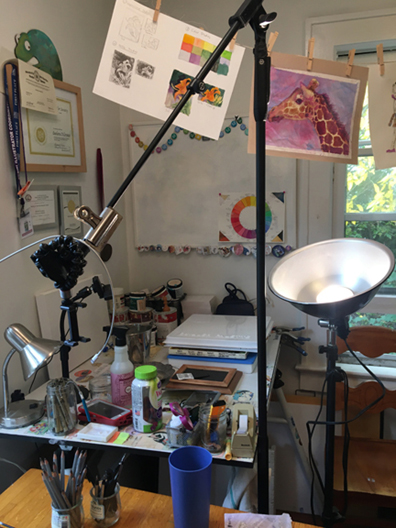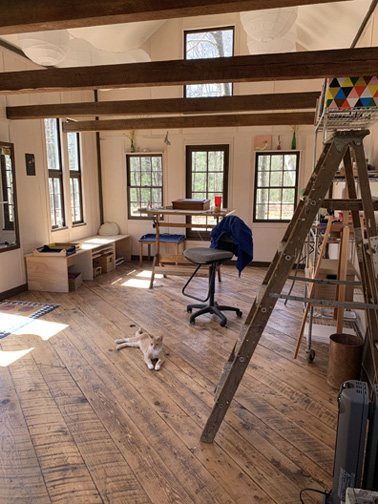 Today we’re visiting author and illustrator, Jessica Love! Her debut picture book, Julián is a Mermaid (Candlewick, 2018), is the story of a young boy who loves mermaids and dresses up like one. And, under the loving acceptance of his Abuela, joins others in a costumed parade. Gorgeously illustrated, the book was a 2019 recipient of the Stonewall Book Awards, sponsored by the Rainbow Round Table of the American Library Association.
Today we’re visiting author and illustrator, Jessica Love! Her debut picture book, Julián is a Mermaid (Candlewick, 2018), is the story of a young boy who loves mermaids and dresses up like one. And, under the loving acceptance of his Abuela, joins others in a costumed parade. Gorgeously illustrated, the book was a 2019 recipient of the Stonewall Book Awards, sponsored by the Rainbow Round Table of the American Library Association.
Her newest book is the radiant Julián at the Wedding (Candlewick, 2020). You can visit Jessica’s Instagram and webpage (and make sure to check out the custom murals she did)!
My fiancé and I moved to this piece of property just as the lockdown was kicking into gear. We are both artists (Daniel is a furniture maker) and had been looking for some land with buildings we could both work on for years.
When we found this place it had an old barn for his woodshop, and a one room schoolhouse which we would convert into my studio. The schoolhouse was not insulated, had no running water or electricity and was the place of residence of three, 6 foot long black snakes.
 Over the course of several months, Daniel transformed the place–he put in windows, did the electrical wiring, and even some ad-hoc plumbing so I could have a functioning sink. He built custom cabinetry, insulated the whole building, hung drywall on the ceiling and made beautiful maple plywood wall finishes, with custom paneling.
Over the course of several months, Daniel transformed the place–he put in windows, did the electrical wiring, and even some ad-hoc plumbing so I could have a functioning sink. He built custom cabinetry, insulated the whole building, hung drywall on the ceiling and made beautiful maple plywood wall finishes, with custom paneling.
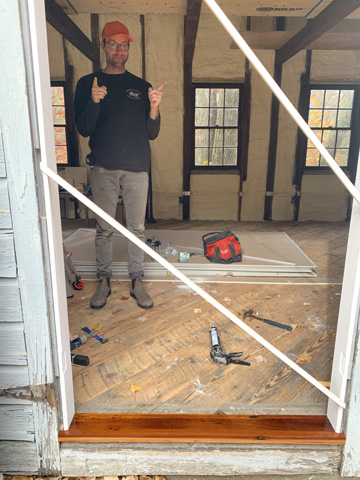 The result is that every surface in my work studio was lovingly hand-made. I get to work inside a present.
The result is that every surface in my work studio was lovingly hand-made. I get to work inside a present.
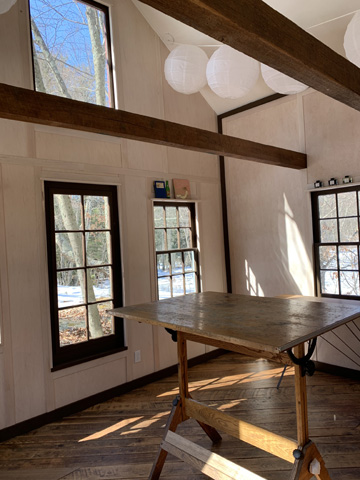 The snakes still live around the building, but we respect each other, and keep our distance. I consider them my co-workers.
The snakes still live around the building, but we respect each other, and keep our distance. I consider them my co-workers.
Images courtesy of Jessica Love

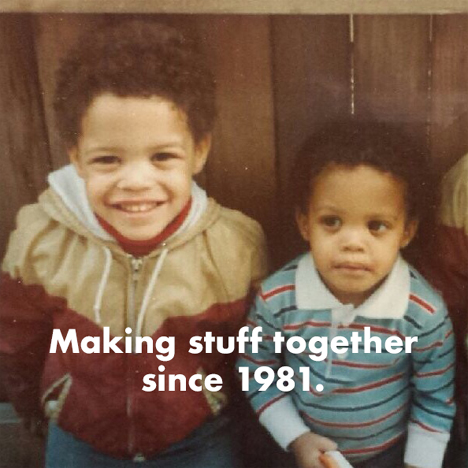
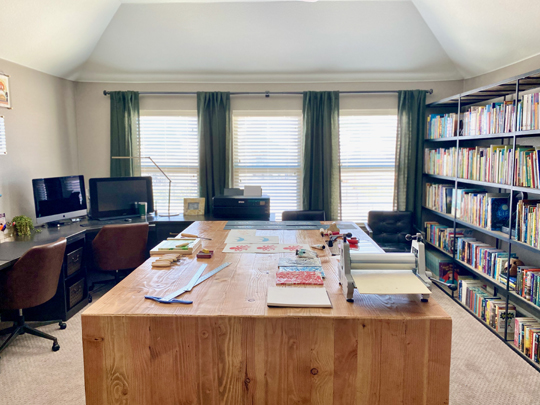
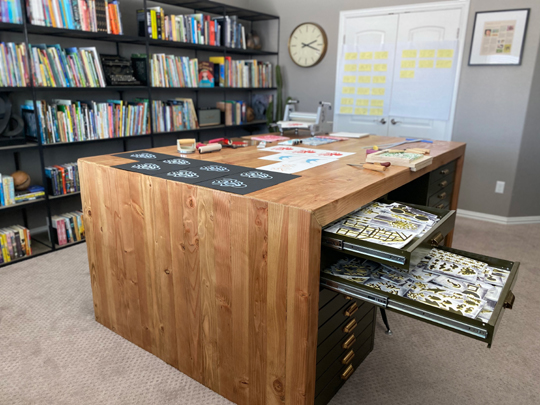 Photo 2: We keep our flat file storage under the bench. We use some of the drawers for storing supplies, but mainly, they store all the stamps and prints we make for every project we do.
Photo 2: We keep our flat file storage under the bench. We use some of the drawers for storing supplies, but mainly, they store all the stamps and prints we make for every project we do.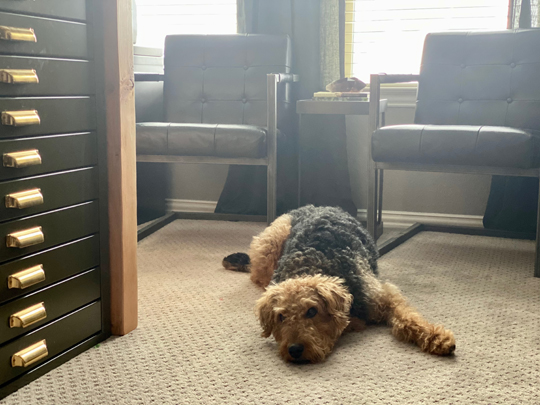 Photo 3: This is Whiskey. She’s our studio assistant. Her primary duty is to lie down right in the way so we’re constantly almost tripping as we move around the space. She keeps us on our toes.
Photo 3: This is Whiskey. She’s our studio assistant. Her primary duty is to lie down right in the way so we’re constantly almost tripping as we move around the space. She keeps us on our toes.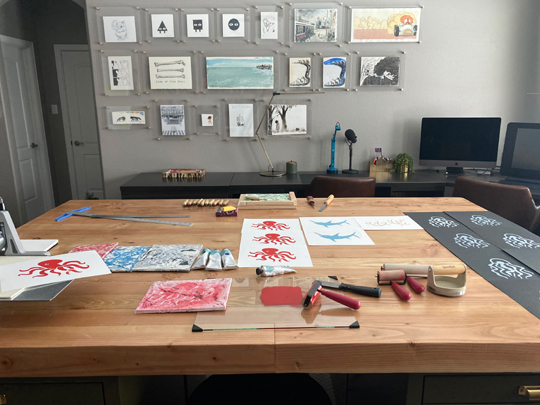 Photo 4: We like to be surrounded by the work of creators we admire, so on one wall Jarrett has a collection of original art from illustrator friends and favorites.
Photo 4: We like to be surrounded by the work of creators we admire, so on one wall Jarrett has a collection of original art from illustrator friends and favorites.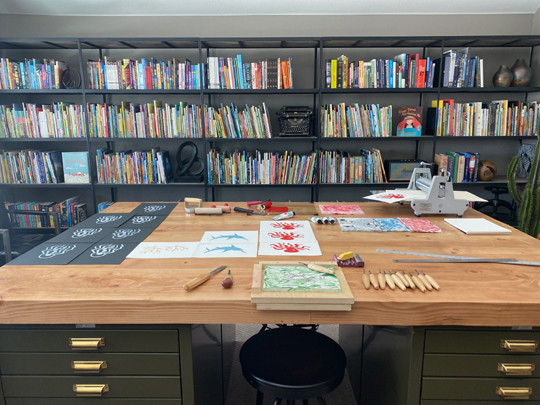 Photo 5: And then on the opposing wall, he has a library of books.
Photo 5: And then on the opposing wall, he has a library of books.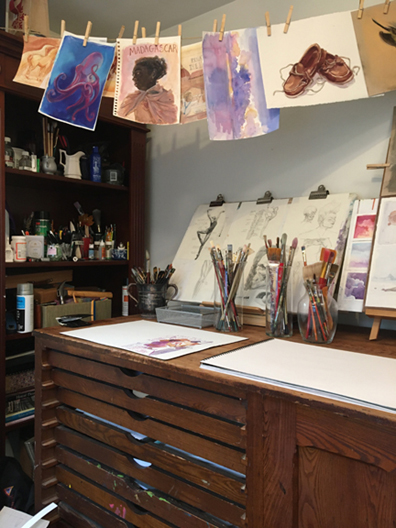 Today, we’ll be visiting Barbara DiLorenzo, a New Jersey-based illustrator, writer, and teacher! Her books include Renato and the Lion (Viking Books, 2017) and Quincy: The Chameleon Who Couldn’t Blend In (Little Bee Books, 2018). In addition to this, Barbara has gone skydiving, hang gliding, surfing, and whitewater rafting. YES! In 2019, we were delighted to invite her to our library to read, make
Today, we’ll be visiting Barbara DiLorenzo, a New Jersey-based illustrator, writer, and teacher! Her books include Renato and the Lion (Viking Books, 2017) and Quincy: The Chameleon Who Couldn’t Blend In (Little Bee Books, 2018). In addition to this, Barbara has gone skydiving, hang gliding, surfing, and whitewater rafting. YES! In 2019, we were delighted to invite her to our library to read, make 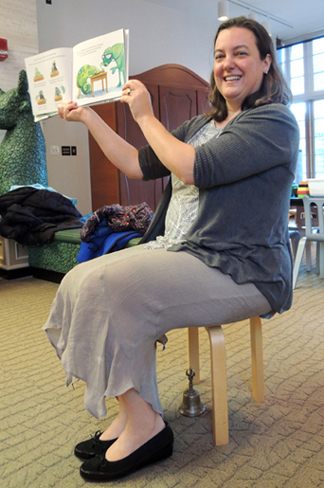
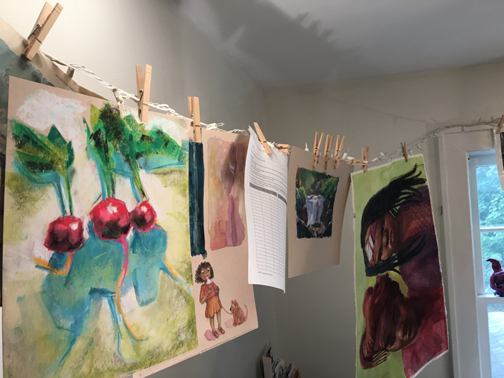 I sit at this desk and Zoom teach art classes – hence the big light and mic stands to hold cameras. I’m a messy artist, so I have to clean up frequently. Otherwise the clay and paint would be all over the keyboard and mouse.
I sit at this desk and Zoom teach art classes – hence the big light and mic stands to hold cameras. I’m a messy artist, so I have to clean up frequently. Otherwise the clay and paint would be all over the keyboard and mouse.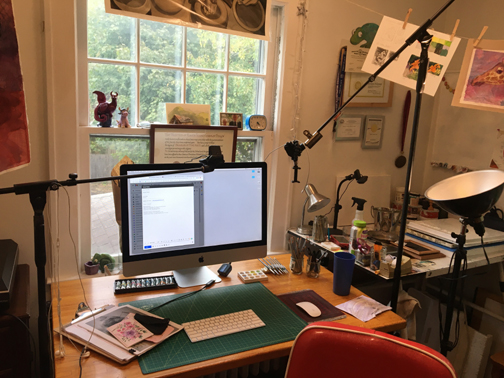 This is another angle of this area – showing that one whole drafting table is covered in paint and other supplies. Even vitamins. Those are important!
This is another angle of this area – showing that one whole drafting table is covered in paint and other supplies. Even vitamins. Those are important!